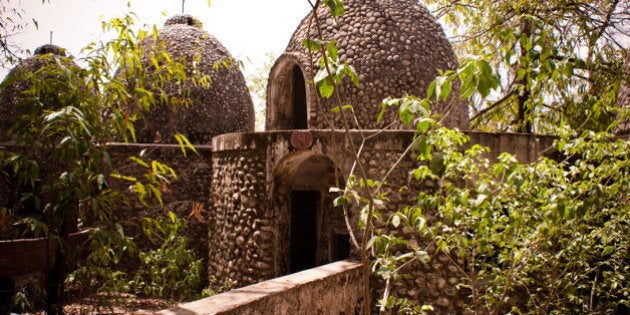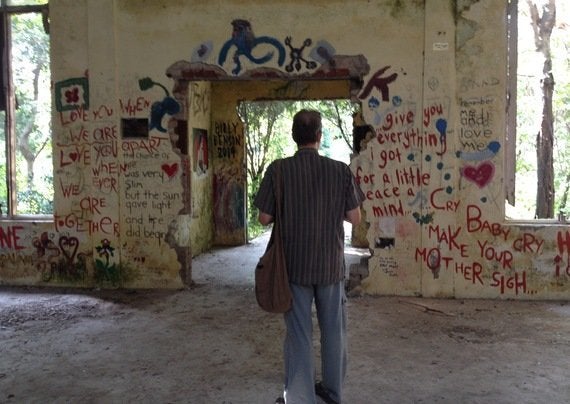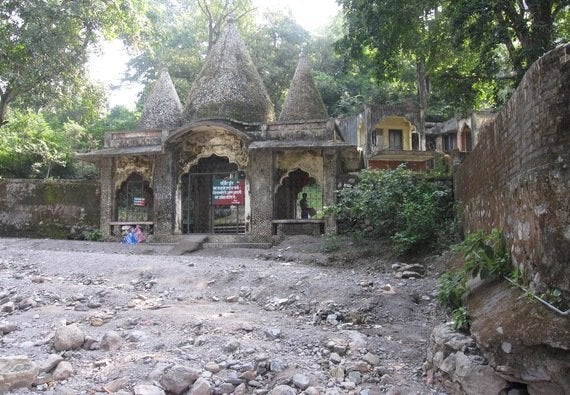

Your life changed in 1967... even if you weren't born yet.
Detroit and Newark exploded in riots ... Hendrix burned his guitar at Monterey ... the friendly cop on the corner was attacking peaceful anti-war protestors ... the Summer of Love drew thousands to San Francisco, who then went back home to middle America and spread the seeds of peace 'n' love (and pot 'n' acid) ...
And the Beatles learned to meditate.
If there's a yoga studio in your town, or if your brother-in-law is taking a meditation class at the Y to lower his blood pressure, or if your Starbucks teacup has an enlightenment-themed message from Oprah printed on its side, you're living in a world that arguably comes out of that moment.
True, by 1967 some of us were already engaged in inner exploration. I was a long-haired college dropout and spiritual seeker, hitchhiking between communes and crash pads and hanging out with Zen teachers and Krishna devotees. But for the mainstream culture, the Beatles' first encounter in England with the tiny, bearded, white-robed Maharishi Mahesh Yogi brought meditation onto the radar. Six months later, in February 1968, the Fab Four set off for Maharishi's ashram (retreat center) in Rishikesh, India. Celebrities like Mia Farrow, Mike Love of the Beach Boys, and the British folk-rocker Donovan were also in attendance, and the world press clamored at the gate. As Philip Goldberg has written in his excellent book American Veda: From Emerson and the Beatles to Yoga and Meditation, "It may have been the most momentous spiritual retreat since Jesus spent those forty days in the wilderness."
In response, overflow crowds turned up at Maharishi's Transcendental Meditation centers throughout the U.S. and Europe. I was in one of those crowds, diverted to a large lecture hall at UCLA, where a mild-mannered American in a suit and tie quietly explained Maharishi's core message -- that meditation could be natural and effortless. After my brief, ill-fated attempts at sit-like-a-rock, concentrate-like-a-laser-beam Zen practice, I was skeptical, but intrigued enough to gamble the modest sign-up fee.
It turned out Maharishi was right. Trying to meditate -- trying to concentrate, push out thoughts, or still the mind -- is counterproductive. The effort to create a non-agitated state is itself a form of agitation. But there are natural ways to let things settle by themselves. In our TM instruction, we were each given a mantra (resonant meditative sound) and shown how to let it dissolve in the mind like a cough drop, eventually leaving inner silence in its place.
I found that this inner silence kept getting clearer, lasting longer, pervading more of my life off the meditation cushion. The results were so spectacular that I soon resolved to become a TM teacher, which meant going to India to train with Maharishi. I wasn't star-struck enough to care that the Beatles had left their retreat early, and in that pre-Internet age I was only dimly aware of rumours that their abrupt departure had something to do with Maharishi's allegedly hitting on female students or trying to involve the Beatles in a messy movie deal. I went back to college and cut my hair, in keeping with Maharishi's strategy of deploying troops of eminently normal-looking teachers to bring this supposedly exotic practice into the mainstream.
In 1970, after two years of faithful twice-a-day meditation, my application to attend teacher training was accepted. I was India bound, headed at last for the land of enlightenment. But overflow had struck again: there were too many of us to fit in the ashram. We wound up spending two extraordinary months with Maharishi, but in Estes Park, Colorado, in the winter, at an unwinterized Boy Scout camp.
No matter. Maharishi had given me a power tool for transforming my own life and those of others. I taught all over the country. Scientific studies came out, confirming the benefits of meditative practice. For regular, non-groovy, middle-class Americans, meditation was becoming an object of respect, not a joke about flying carpets or beds of nails.
But just as things were getting easy, Maharishi started making them hard. The message of natural, effortless, scientifically validated meditation was still there, but he now he also offered courses in levitation. He launched a line of expensive health supplements. He founded schools and colleges -- fair enough -- but also kept trying to launch a meditation theme park with magic special effects. He scolded national leaders for failing to fund his increasingly ambitious projects. Eventually, he issued his own currency, appointed his own kings of various countries, and offered a guaranteed-enlightenment course: price of admission, a million dollars.
I watched all this with growing alarm. It was getting harder to deny that the man who, for me, embodied cosmic wisdom also had more than a touch of megalomania. Who knows? Maybe when the opportunity presents itself, the urge to build empires can seize anyone, even a sage. Still I held on, figuring that the message was more important than the messenger. The meditation worked. I had letters from students who had emerged from all kinds of traumas and addictions, some of them thanking me for saving their lives.
Then, one day, Maharishi jacked up the prices. I'd been teaching a lot of high school students, and instead of $85 I was now required to charge $2,500. To this day I don't know what he was thinking, but clearly it was time to move on.
I reentered the wider world in which there are many sublime teachers, some of whom also teach natural, effortless meditation, but with labels other than TM. I peppered them with questions, test drove their methods, and concluded that Maharishi didn't have a monopoly on effortlessness after all. These days I happily teach natural meditation with no labels at all.
And this fall I finally made it to Maharishi's ashram. (He died in Holland in 2008, at the age of 90.) It was my fourth trip to India, but my first time in Rishikesh, in the foothills of the Himalayas, where the Ganges is cold but clean enough for Westerners to bathe in it. Lining both sides of the river, Rishikesh is traditionally a place of saints and yogis, where every chai or silk merchant seems to have a picture of his favorite guru on the wall. It took nearly a week till I spotted one lonely photo of Maharishi, in the grocery stall of a sweet older gent who told me he had served Maharishi and the Beatles all those years ago.
Finding the ashram was a bit of an excursion. Maharishi had leased the land from the local government, which eventually evicted him and then abandoned the place to the elements. To find it you have to ask your way to "The Beatles Ashram" -- that's even what it's called on the map you get at the local travel bureau.
On our last day in Rishikesh, my wife, three friends, and I crossed the narrow Ram Jhula footbridge, which is crowded not only with pedestrians but with crippled beggars, honking motorcycles, aggressive monkeys (don't look the brown ones in the eye), and the occasional cow. Once on the east side of the river, we turned right and walked past shops and temples, street musicians and mendicant holy men, children in starched school uniforms and Westerners in soft cotton yoga togs.

In the outskirts of town, we found one hand-painted, very unofficial sign pointing us towards The Beatles Ashram. Finally, in a quiet, wooded, hilly section, we reached the imposing front gate where paparazzi had once swarmed, now marked only by a sign in Hindi identifying the place as property of the government forest service. Just as we had been told to expect, there was a guy at the gate, supposedly a guard although he had no uniform, who let us each through for 100 rupees (about $1.50).
Aside from us and five or six other curious Westerners, the place was empty. We wandered about and soon came to the cluster of little stone beehive-shaped meditation huts I had heard of years before -- you had to watch out for the scorpions. In one of them, Prudence Farrow, Mia's beautiful sister, did long hours of marathon meditation, prompting the Beatles to write "Dear Prudence," urging her to come out and play. (Their few weeks of extended meditation sparked a surge of creativity. They wrote most of the White Album here, including John Lennon's bitter song of disillusionment, "Sexy Sadie," originally titled "Maharishi.") I sat down in a hut, did a few minutes of meditation, then moved on.

Walking past decaying dormitories, we finally came to what had been the lecture hall. It was cavernous, the windows and doors gone, the roof falling in. The walls were covered with graffiti, a sprawling collage of hippie psychedelia, cosmic symbols and slogans, poster-style portraits of spiritual leaders including Maharishi and the Dalai Lama, and, everywhere, lyrics to Beatles songs.
It was a strange moment for me. I was 44 years late, but I had arrived. There was power here. Yes, I had a personal connection to this spot: the memory of my youthful naïveté, the mythic quality of a destination long deferred. But this was also the place where the world had changed, whether the world knew it or not, remembered it or not. And it was also a crumbling memorial to the eventual fate of all empires, whether political or spiritual.
One of my companions asked if I would offer up an appropriate mantra or prayer. I closed my eyes for a moment, then chanted Shankara's verses of guru devotion, which are sung all over India in gratitude to the generations of sages who have preserved the knowledge of inner awakening, and which Maharishi had taught us to sing each time we passed that knowledge to a new student.
Then it was time to go.
Maharishi broke my heart. But he also propelled me on my mission, even if I finally had to fulfil it my own way.